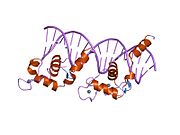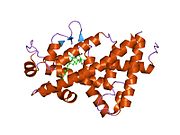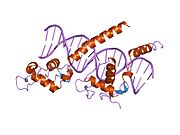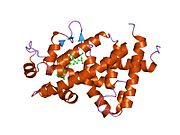Vitamin D receptor
Ensembl | |||||||||
|---|---|---|---|---|---|---|---|---|---|
| UniProt | |||||||||
| RefSeq (mRNA) |
| ||||||||
| RefSeq (protein) |
| ||||||||
| Location (UCSC) | Chr 12: 47.84 – 47.94 Mb | Chr 15: 97.75 – 97.81 Mb | |||||||
| PubMed search | [3] | [4] | |||||||
| View/Edit Human | View/Edit Mouse |
The vitamin D receptor (VDR also known as the calcitriol receptor) is a member of the
VDR is expressed in most tissues of the body, and regulates transcription of genes involved in
Function
The VDR gene encodes the nuclear hormone receptor for vitamin D. The most potent natural agonist is calcitriol (1,25-dihydroxycholecalciferol) and the vitamin D2 homologue ercalcitriol, 1-alpha,25-dihydroergocalciferol) is also a strong activator. Other forms of vitamin D bind with lower affinity, as does the secondary bile acid lithocholic acid. The receptor belongs to the family of trans-acting transcriptional regulatory factors and shows similarity of sequence to the steroid and thyroid hormone receptors.[10]
Downstream targets of this nuclear hormone receptor include many genes involved in mineral metabolism.[8] The receptor regulates a variety of other metabolic pathways, such as those involved in the immune response and cancer.[9] VDR variants that bolster vitamin-D action and that are directly correlated with AIDS progression rates and VDR association with progression to AIDS follows an additive model.[11] FokI polymorphism is a risk factor for enveloped virus infection as revealed in a meta-analysis.[12] The importance of this gene has also been noted in the natural aging process were 3’UTR haplotypes of the gene showed an association with longevity.[13]
Clinical relevance
Mutations in this gene are associated with type II vitamin D-resistant rickets. A single nucleotide polymorphism in the initiation codon results in an alternate translation start site three codons downstream. Alternative splicing results in multiple transcript variants encoding the same protein.[14] VDR gene variants seem to influence many biological endpoints, including those related to osteoporosis [15]
The vitamin D receptor plays an important role in regulating the hair cycle. Loss of VDR is associated with hair loss in experimental animals.
Researchers have focused their efforts in elucidating the role of VDR polymorphisms in different diseases and normal phenotypes such as the HIV-1 infection susceptibility and progression or the natural aging process. The most remarkable findings include the report of VDR variants that bolster vitamin-D action and that are directly correlated with AIDS progression rates, that VDR association with progression to AIDS follows an additive model[11] and the role of FokI polymorphism as a risk factor for enveloped virus infection as revealed in a meta-analysis.[12]
Interactions
Vitamin D receptor has been shown to
Interactive pathway map
Click on genes, proteins and metabolites below to link to respective articles. [§ 1]
- ^ The interactive pathway map can be edited at WikiPathways: "VitaminDSynthesis_WP1531".
References
- ^ a b c GRCh38: Ensembl release 89: ENSG00000111424 – Ensembl, May 2017
- ^ a b c GRCm38: Ensembl release 89: ENSMUSG00000022479 – Ensembl, May 2017
- ^ "Human PubMed Reference:". National Center for Biotechnology Information, U.S. National Library of Medicine.
- ^ "Mouse PubMed Reference:". National Center for Biotechnology Information, U.S. National Library of Medicine.
- S2CID 85996383.
- PMID 23362149.
- PMID 1662663.
- ^ PMID 21182397.
- ^ PMID 16848743.
- S2CID 1190488.
- ^ PMID 24768180.
- ^ S2CID 51955566.
- S2CID 34809120.
- ^ "Entrez Gene: VDR vitamin D (1,25- dihydroxyvitamin D3) receptor".
- S2CID 51710351.
- S2CID 23876206.
- PMID 25180455.
- PMID 10967105.
- ^ PMID 12837248.
- PMID 20015453.
- ^ PMID 10198638.
- ^ PMID 9878542.
- ^ PMID 12460926.
- PMID 10748178.
- ^ PMID 11514567.
- PMID 12612084.
- ^ PMID 9632709.
- PMID 11909970.
- PMID 11719366.
Further reading
- Hosoi T (2002). "[Polymorphisms of vitamin D receptor gene]". Nippon Rinsho. 60 (Suppl 3): 106–10. PMID 11979895.
- Uitterlinden AG, Fang Y, Van Meurs JB, Pols HA, Van Leeuwen JP (2004). "Genetics and biology of vitamin D receptor polymorphisms". Gene. 338 (2): 143–56. S2CID 11023870.
- Norman AW (2007). "Minireview: vitamin D receptor: new assignments for an already busy receptor". Endocrinology. 147 (12): 5542–8. PMID 16946007.
- Bollag WB (2007). "Differentiation of human keratinocytes requires the vitamin d receptor and its coactivators". J. Invest. Dermatol. 127 (4): 748–50. PMID 17363957.
- Bugge TH, Pohl J, Lonnoy O, Stunnenberg HG (1992). "RXR alpha, a promiscuous partner of retinoic acid and thyroid hormone receptors". EMBO J. 11 (4): 1409–18. PMID 1314167.
- Goto H, Chen KS, Prahl JM, DeLuca HF (1992). "A single receptor identical with that from intestine/T47D cells mediates the action of 1,25-dihydroxyvitamin D-3 in HL-60 cells". Biochim. Biophys. Acta. 1132 (1): 103–8. PMID 1324736.
- Saijo T, Ito M, Takeda E, Huq AH, Naito E, Yokota I, Sone T, Pike JW, Kuroda Y (1991). "A unique mutation in the vitamin D receptor gene in three Japanese patients with vitamin D-dependent rickets type II: utility of single-strand conformation polymorphism analysis for heterozygous carrier detection". Am. J. Hum. Genet. 49 (3): 668–73. PMID 1652893.
- Szpirer J, Szpirer C, Riviere M, Levan G, Marynen P, Cassiman JJ, Wiese R, DeLuca HF (1992). "The Sp1 transcription factor gene (SP1) and the 1,25-dihydroxyvitamin D3 receptor gene (VDR) are colocalized on human chromosome arm 12q and rat chromosome 7". Genomics. 11 (1): 168–73. PMID 1662663.
- Yu XP, Mocharla H, Hustmyer FG, Manolagas SC (1991). "Vitamin D receptor expression in human lymphocytes. Signal requirements and characterization by western blots and DNA sequencing". J. Biol. Chem. 266 (12): 7588–95. PMID 1850412.
- Malloy PJ, Hochberg Z, Tiosano D, Pike JW, Hughes MR, Feldman D (1991). "The molecular basis of hereditary 1,25-dihydroxyvitamin D3 resistant rickets in seven related families". J. Clin. Invest. 86 (6): 2071–9. PMID 2174914.
- Sone T, Marx SJ, Liberman UA, Pike JW (1991). "A unique point mutation in the human vitamin D receptor chromosomal gene confers hereditary resistance to 1,25-dihydroxyvitamin D3". Mol. Endocrinol. 4 (4): 623–31. PMID 2177843.
- Baker AR, McDonnell DP, Hughes M, Crisp TM, Mangelsdorf DJ, Haussler MR, Pike JW, Shine J, O'Malley BW (1988). "Cloning and expression of full-length cDNA encoding human vitamin D receptor". Proc. Natl. Acad. Sci. U.S.A. 85 (10): 3294–8. PMID 2835767.
- Hughes MR, Malloy PJ, Kieback DG, Kesterson RA, Pike JW, Feldman D, O'Malley BW (1989). "Point mutations in the human vitamin D receptor gene associated with hypocalcemic rickets". Science. 242 (4886): 1702–5. PMID 2849209.
- Rut AR, Hewison M, Kristjansson K, Luisi B, Hughes MR, O'Riordan JL (1995). "Two mutations causing vitamin D resistant rickets: modelling on the basis of steroid hormone receptor DNA-binding domain crystal structures". Clin. Endocrinol. 41 (5): 581–90. S2CID 40851942.
- Malloy PJ, Weisman Y, Feldman D (1994). "Hereditary 1 alpha,25-dihydroxyvitamin D-resistant rickets resulting from a mutation in the vitamin D receptor deoxyribonucleic acid-binding domain". J. Clin. Endocrinol. Metab. 78 (2): 313–6. PMID 8106618.
- Maruyama K, Sugano S (1994). "Oligo-capping: a simple method to replace the cap structure of eukaryotic mRNAs with oligoribonucleotides". Gene. 138 (1–2): 171–4. PMID 8125298.
- Yagi H, Ozono K, Miyake H, Nagashima K, Kuroume T, Pike JW (1993). "A new point mutation in the deoxyribonucleic acid-binding domain of the vitamin D receptor in a kindred with hereditary 1,25-dihydroxyvitamin D-resistant rickets". J. Clin. Endocrinol. Metab. 76 (2): 509–12. PMID 8381803.
- Kristjansson K, Rut AR, Hewison M, O'Riordan JL, Hughes MR (1993). "Two mutations in the hormone binding domain of the vitamin D receptor cause tissue resistance to 1,25 dihydroxyvitamin D3". J. Clin. Invest. 92 (1): 12–6. PMID 8392085.
- Jurutka PW, Hsieh JC, Nakajima S, Haussler CA, Whitfield GK, Haussler MR (1996). "Human vitamin D receptor phosphorylation by casein kinase II at Ser-208 potentiates transcriptional activation". Proc. Natl. Acad. Sci. U.S.A. 93 (8): 3519–24. PMID 8622969.
- Lin NU, Malloy PJ, Sakati N, al-Ashwal A, Feldman D (1996). "A novel mutation in the deoxyribonucleic acid-binding domain of the vitamin D receptor causes hereditary 1,25-dihydroxyvitamin D-resistant rickets". J. Clin. Endocrinol. Metab. 81 (7): 2564–9. S2CID 46366654.
External links
- Calcitriol+Receptors at the U.S. National Library of Medicine Medical Subject Headings (MeSH)
- Nuclear Receptor Resource
- Vitamin D Receptor: Molecule of the Month Archived 2015-10-16 at the Wayback Machine
- IUPHAR: Vitamin D receptor
- Overview of all the structural information available in the PDB for UniProt: P11473 (Vitamin D3 receptor) at the PDBe-KB.
This article incorporates text from the United States National Library of Medicine, which is in the public domain.
















